Tips to help you start your tomato plants from seed or seedling, tomato plant care, and a tasty recipe for Tomato Basil and Feta Salad.
DOWNLOAD PRINT VERSION
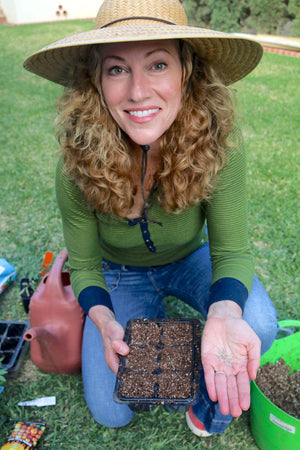
If You Start From Seed
What You Need
1. Seeds: It’s important to note that tomato plants are often categorized as Determinate or Indeterminate.
Determinate - varieties of tomatoes that have a shorter growing season and stay more compact in size.
Indeterminate - varieties of tomatoes that have a longer more abundant growing season, but they also require pruning and vine support through using a trellis, stakes, or tomato cages.
Check your seeds to see which category they fall under, and once you know, pick the seeds that fit your space and growing goals.
2. Small Pots: Each pot or planting cell should be at least 3 inches deep with good drainage. Some pots come with moisture domes or coverings that create a greenhouse effect and provide an optimal environment for seed germination. (Once sprouts break soil surface though, ditch the cover. What those little green leaves need now is plenty of sun!)
3. Seed Starting Soil: Not only does this light fluffy soil retain moisture better, but small sprouts will have difficulty reaching the surface if the soil contains large pieces of material.
4. A Warm Location: Ideal temperatures for seeds and seedlings are between 70-80 degrees but can go as low as 55 degrees. A greenhouse or heated location indoors does the trick to keeping your seeds warm. (Consistent moisture and warmth are key!)
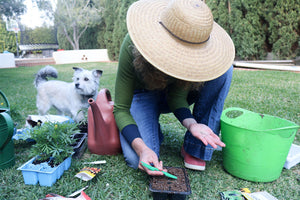
If You Start From Seed
What You Do
1. Pour some seed starting soil into a large bowl or bucket.
2. Add water to the soil so that the mixture throughout becomes slightly damp. (When you gently squeeze the soil, it should drip slightly but not produce a stream.)
3. Using your hands or a spoon, fill your pots or planting cells 3⁄4 of the way.
4. Use a pencil point or seed sowing tool to poke a small hole in the center of each pot (1⁄4” deep).
5. Insert a seed (maybe two) in each hole and gently cover the seed/s with soil.
6. Dampen seeds by misting with a spray bottle and place your pots in a warm location.
7. Once you see little sprouts, make sure they get plenty of sun to avoid them straining for UV rays and growing long, thin, and weak (sometimes referred to as “leggy”).
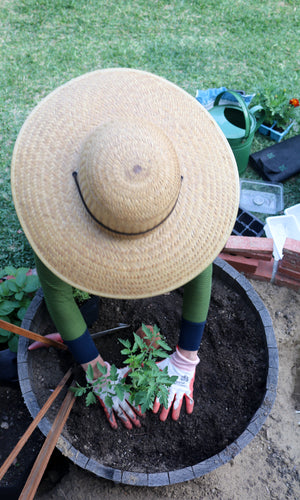
Planting Seedlings
Successful Transplanting
1. When the weather is warm enough, with NO danger of freezing, find a location where your tomato plant/s will get plenty of full sun (at least 6-8 hours each day), and plenty of space for the plant to grow (it may surprise you how much larger they will get).
2. If transplanting into the ground or a garden bed, dig the hole to match the depth of the pot currently holding the seedling. If you plan to move your seedling into a large pot, first add some good soil and then dig a hole to accommodate the right seedling depth.
3. Add water into the hole that will be the new seedling's home. This helps to hydrate plant roots and avoid the plant from going into transplant “shock” in its new location.
4. Now, holding onto the plant's base, slowly tip the seedling sideways and pull out the plant while gently squeezing the seedling pot. Soil will detach from the roots, but that’s ok. It is not part of the tomato plant, and the roots will be in new soil soon enough!
5. To note: Sometimes seedling roots become root-bound (growing sideways or in a spiral). If that’s the case, gently break them apart to allow those roots to trail down.
6. Gently place the tomato plant into its new home. Continue adding soil to cover the stem to the base of the first set of leaves. (If some small bottom leaves get buried, those leaves and branches will become underground roots, which lead to a stronger plant. Just make sure there are still plenty of leaves above to absorb sunlight for the plant to grow.)
7. Pat the tomato plant in place and then give it a fair amount of hydration, watering where the plant's base now meets the soil.
8. Monitor your seedling and water as needed. Keep in mind that tomatoes like to be watered deeply, but also infrequently. (1 inch every 4-7 days, depending on weather.)
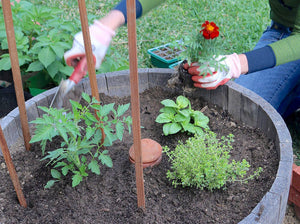
Companion Planting
Companion planting is the method of growing multiple crops together. If done right,the crops can both enhance and protect one another.
Tomato Plant “Bros” (awesome companion crops): Basil, Thyme, Carrots, Borage, Chives, Calendula, Onions, Marigold Flowers, Mint, Oregano, Peppers
Tomato Plant “Foes” (crops to avoid): Beans, Corn, Dill, Fennel, Potatoes, Rosemary
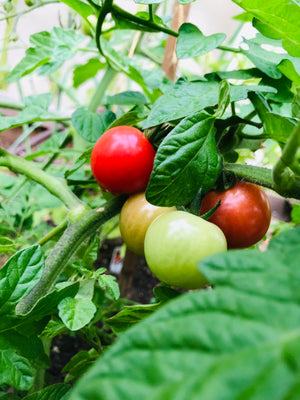
Tomato Plant Care
Support
Most tomato varieties are vining plants that need extra help to support the weight of stems, leaves, and juicy fruits. You can get creative with support solutions, but we like to use tomato cages, trellises, or stakes. I also use twine to gently tie the vines to the structures to help steer growth direction and give the plants even more assistance.
(Tip: position your cage or stakes into the soil before inserting your seedling. This way, you won’t damage any of the roots, but rather the roots will grow around the structures.)
Suckers
Suckers are shoots (or small stems) that grow out of the joint where your tomato branch intersects with the stem. Suckers will not harm your plant, but each one has the potential to become its own large branch, drawing energy away from the plant and not producing as much fruit. You can remove small suckers by pinching them off with your thumb and forefinger. More established suckers may need the help of trimmers.
Airflow
Good airflow is SUPER important. It prevents fungal disease while also helping leaves dry out, which increases the amount of moisture and nutrients absorbed through plant roots. To increase airflow, remove suckers (see above) and any yellow or decaying leaves.When your tomato plant is about 3 feet tall, it is also beneficial to remove the leaves from the bottom foot of the stem.
Pest Control
One of the best ways to control pests is to create an environment that isn't to their liking. Companion planting deters many tomato-loving pests that are not so keen on some other crops' strong scents (like basil, onions, and marigolds).
Give ‘em a Boost!
Every two weeks, add one Tablespoon of Epsom Salt to your watering can and water at the base of each plant. Epsom Salt contains Magnesium, which aids both chlorophyll and fruit production. (Watering tip: Tomatoes like to be watered deeply and infrequently.)
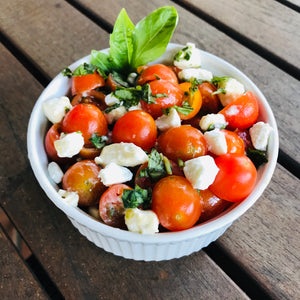
Tomato Basil and Feta Salad
Ingredients
2 Cups of *Cherry Tomatoes
2 Tbsp of Fresh Basil (chopped)
1⁄4 Cup of Feta Cheese Crumbles
4 tsp of White Wine Vinegar
4 tsp of Olive Oil
1⁄4 tsp of Sea Salt
Directions
1. Cut your Cherry Tomatoes into halves.
2. Mix the Vinegar, Olive Oil, and Salt in a medium sized bowl.
3. Stir in the Cherry Tomatoes, Feta Cheese, and Basil.
4. Enjoy as a side or refreshing appetizer!
You can can also experiment with:
*Any variety of tomato you are growing will work when halved or chopped into bite sized pieces!
Substitute Goat Cheese Crumbles in place of Feta Cheese.
Add a teaspoon of minced Garlic or Shallots to the dressing.


